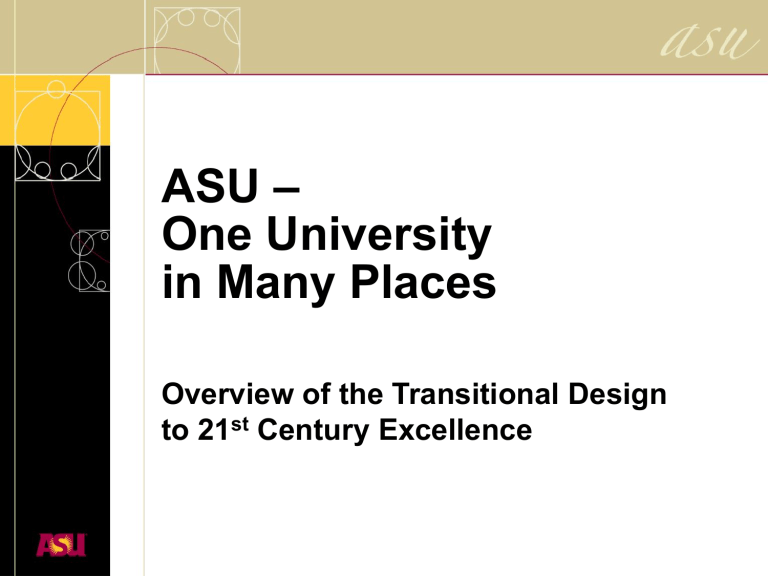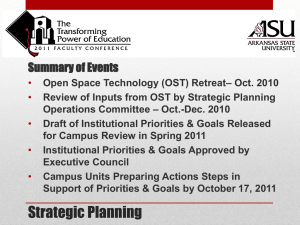OneUniversity
advertisement

ASU – One University in Many Places Overview of the Transitional Design to 21st Century Excellence Objective of the Design Process Build a comprehensive metropolitan research university that is an unparalleled combination of academic excellence and commitment to its social, economic, cultural, and environmental setting. ASU Challenges Rapid socio/economic change Increased global competition Rapid cultural diversification Limited higher education infrastructure Underperforming pre K-20 education ASU Evolution Stages of ASU evolutionary history Physical constraints on the Tempe campus Limited public and private support for ASU ASU Design Options Replication Model Minnesota, Ohio State, UCLA Incremental Model Linear extrapolation to future from ASU of today Differentiation Model Building the New American University New American University: Design Imperatives ASU Must Become a Force, and Not Only a Place ASU as Entrepreneur Pasteur’s Principle A Focus on the Individual ASU Must Embrace Its Cultural, Socioeconomic, and Physical Setting Intellectual Fusion Social Embeddedness Global Engagement New American University: Differentiation Model Build on existing strengths of ASU: New, flexible academic units Strong cooperative environment of staff, faculty and students Strong and deep linkages to the community Nationally competitive interdisciplinary traditions New American University: Differentiation Model Build for 21st century Build for teaching and discovery Build for the community: the University as social enterprise Build colleges/schools and college/school clusters (campuses) that are different in kind but equal in quality ASU Design Approach: College/School Centric Build the University around strong, entrepreneurial colleges/schools. Create a design that allows colleges/schools to grow and prosper to their intellectual and market limits. Create a federation of unique colleges/schools as the foundation of the premier metropolitan research university in the United States. College/School Centric Model: Competition University success will be driven by academic excellence, social, economic and cultural impact and creativity attained by communities of students, faculty and staff driven to compete at the highest level. Competition is nurtured and enhanced by close-knit organizations with focused missions and high degrees of freedom. In our case, COLLEGES & SCHOOLS. College/School Centric Model: Empowerment Overcome historical physical and fiscal constraints through school level ownership Encourage and allow new designs and new directions to gain distinctive differentiation for ASU colleges/schools Empower each college/school to compete at the highest level for students, faculty and resources College/School Centric Model: Transformation to New ASU Model Unique intellectual identity within ASU Unique physical identity within ASU College/School centric plan for success Targeted competitors School specific metrics for success College/School Centric Model: Conceptualization & Design Existing Colleges/Schools Incremental changes after careful planning New directions, new models and new space for many New and differentiated names College/School Centric Model: Conceptualization & Design Re-Designed and New Colleges/Schools Interdisciplinary initiativites Transdisciplinary initiatives New environments for intellectual fusion College/School Centric Model: Conceptualization & Design Examples of New Colleges & Schools School of Life Sciences (Tempe campus) School of Criminal Justice (West campus) University College (Capital Center campus) School of Industrial Administration (Polytechnic campus) College/School Centric Model: Implementation Phase 0 Design and Planning 2004 – 2006 (1-2 years, depending on program) Phase 1 Implementation 2005 – 2009 (2-4 years depending on programs and facility needs) Phase 2 University Integration & Linkage 2007 – 2012 (3-5 years, depending on program) College/School Centric Model: Implementation By 2012 – On path to be the next great university of America — shaped by its era, its place and its environment. Summary: Tempe campus College of Architecture and Environmental Design will offer select programs to students on other campuses. Herberger College of Fine Arts will develop an arts presence on the Capital Center campus and on the Polytechnic campus. Del E. Webb School of Construction will continue to be headquartered on the Tempe campus within the Ira. A. Fulton School of Engineering; the school will offer a construction management program on the Tempe campus, and a construction technology program on the Polytechnic campus. Summary: Polytechnic campus Movement of Technology and Applied Sciences School to top 5-7 in the U.S. General engineering program Real Estate program Physical Education Program School of Industrial Administration Construction Technology Program Summary: West campus School of Criminal Justice & Criminology Recreation and Tourism Management Program College of Teacher Education and Leadership Summary: Capital Center campus College of Nursing Public College School of Public Affairs School of Community Development and Service School of Social Work Morrison Institute for Public Policy Summary: Capital Center campus Cronkite School of Journalism KAET (Channel 8) The School of Health Management and Policy University College School of Interdisciplinary Studies Community College Alliance Extended Education Education, business and communications programs Summary: Other Significant Decisions College of Law will continue to explore alternate program opportunities. Hugh Downs School of Human Communication will remain on the Tempe campus and become part of the College of Liberal Arts and Sciences. Justice Studies on the Tempe campus will become the School of Social Inquiry and will decide if it should relocate to the Capital Center campus or become part of the College of Liberal Arts and Sciences on the Tempe campus.






